MPs are making their way back to Parliament with an order from Speaker Sir Lindsay Hoyle ringing in their ears. In the post-Zoom world, they must smarten up their appearance. ‘Members are expected to wear business attire in and around the Chamber,’ Hoyle reminded them.
‘Jeans, chinos, sportswear or any other casual trousers are not appropriate. T-shirts and sleeveless tops are not business attire,’ continued his memo. ‘Men are encouraged to wear a tie, and jackets must be worn.’
Good for you, Mr Speaker! Perhaps you could send a similar directive to the rest of the country too. After 18 months of working from home, it’s not just MPs who have forgotten how to dress. Jeans and hoodies, track suits and athleisure have replaced formal business wear. It was reported last week that Marks & Spencer, purveyor of men’s suits since 1939, no longer stocks this traditional business attire in over half of its stores. Demand for the matching two-piece was just too small to justify the rack space.
A new, more subtle, reverse snobbery has crept into the way we dress.
Both men and women have clearly used lockdown as an opportunity to ditch stuffy workwear associated with the office. Trousers or skirts with actual buttons, buckles and zips, have, it seems, been too much for many of us. But the end of business attire should trouble us and Sir Lindsay nails why.
His dress code memo prompts MPs to remember: ‘The way in which you dress should demonstrate respect for your constituents, for the House and for the institution of Parliament in the life of the nation.’ How we look reflects our attitude to the job we do. Looking smart says we not only take ourselves seriously, but our work and our colleagues too.
Dressing up for work marks a distinction between our public and private lives. It’s the sartorial demarcation between weekends and weekdays. Putting on a suit signifies leaving the intimacy of the domestic sphere and entering society where we will be in the company of other people. Dressing smartly demonstrates our respect for these people.
Lindsay Hoyle’s instruction to MPs differs from that of his predecessor. When he was in the Speaker’s chair, John Bercow, declared that there was, ‘no exact dress code’. His final memo on the matter said business clothing was ‘merely a suggestion’.
This differing advice hints at a new class divide. A decade and more ago, wearing a suit to work was what distinguished the middle class from the working class, white collar workers from blue collar toilers. For socially mobile working class youngsters, a job that required a suit was something to aspire towards. Heading to Marks & Spencer to make that purchase was a sign that you were on the up. Now, all this has changed. A new, more subtle, reverse snobbery has crept into the way we dress.
When I landed a job in academia, I couldn’t believe my luck. Growing up, it seemed unimaginable to me that I would ever be a university lecturer. To mark the occasion, I went out and bought myself a smart navy blue skirt suit from Next. I wanted to look the part. One week in, my head of department ran into me in the staff kitchen. ‘Oh! You look just like a secretary!’ was her throwaway greeting. But she was right – I did.
My embarrassment brought home to me the sartorial reality of the campus. Lowly paid admin staff almost all dressed smartly, with shirts and jackets and even the occasional tie. Meanwhile, well paid academics swanned around in jeans and jumpers.
Today, the requirement to wear a suit to work is more often than not reserved for those employed in junior positions, perhaps a call centre, or a customer facing role. The luxury of looking scruffy at work is one that only middle class professionals enjoy. They are far too important for dress codes – and they want the world to know it.
But the studied informality of the middle classes comes with its own subtle demarcations. And despite the Speaker’s edicts, this finely tuned sartorial distinction has made its way to the heart of government. In November last year, photographs of Chancellor Rishi Sunak, hard at work but wearing a hoodie, were beamed around the world. The not so subtle message was that Sunak may be one of the most important people in the country but he’s really just like the rest of us. Only, he’s not. Sunak, as we know, is fabulously wealthy. His hoodie was no Sports Direct ‘2 for £20’ job – it was rumoured to be from Everlane: ‘an American brand which prides itself on ethical factories and total transparency in the supply chain and pricing.’ This signals status to others in the know.
So three cheers for Lindsay Hoyle. I for one am glad he is rebuking the slobby-but-snobby middle classes. They need to pull their socks up and show some respect to everyone else.







Comments